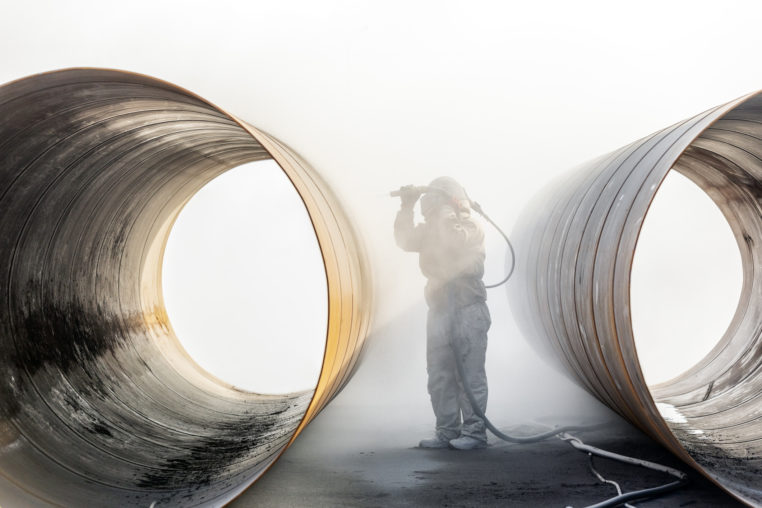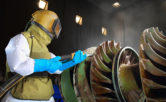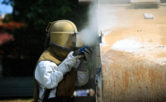
Differences Between Media Blasting, Soda Blasting, and Sandblasting
The process of removing paint, rust, or other surface contaminants from metal surfaces is called blasting. In blasting, suction is created by compressed air or a liquid agent to pull paint, rust, lead, or other contaminants off the surface and into the air. This process can be done in a variety of ways and it is important to choose the right one for the job:
- Media blasting uses a media blast cabinet to apply high-pressure air, water, or steam to break down the contaminants and remove them from the surface.
- Soda blasting uses a high-pressure stream of pressurized soda solution that contains a mixture of sodium bicarbonate and water. Soda blasting is often used for copper surfaces that are being coated with nickel, chrome, or other metals.
- Sand blasting uses sand particles under high pressure with oxygen to remove contaminants from metal surfaces such as steel, iron, aluminum, brass, tungsten carbide, titanium, and graphite. The particles are small enough so they don’t embed themselves into the metal like concrete does when it’s blasted off a building. Sandblasting is typically used for rust removal on non-ferrous metals.
Choosing the Ideal Blasting Method
Media blasting is generally used to remove paint, rust, and other contaminants from ferrous metal surfaces while soda blasting is used to remove paint, rust, and other contaminants from non-ferrous metals. Both methods are used to remove paint and rust. However, soda blasting works faster than media blasting because soda can cut through the paint and rust whereas media blasting has to work at it longer to get through the paint and onto the bare metal.
Soda Blasting Vs. Sand Blasting
Sandblasting doesn’t remove paint and rust as soda blasting does and it takes a while to get the surfaces clean of loose contaminants. Sandblasting works well on surfaces that are made out of concrete. No particle embeds itself into the surface.
Sandblasting uses sand particles under high pressure with oxygen to remove contaminants from metal surfaces such as steel, iron, aluminum, brass, tungsten carbide, titanium, and graphite.
Media blasting is the most common way to remove surface contaminants from metal. The process involves removing paint and rust by using high-pressure air, water, or steam to break them down and pull them away from the surface. For example, media blasting can be used on aircraft parts that must-have stainless steel rust removed. It has also been used in high-pressure air scrubbers for fuel systems and engine parts. Media blasting is also used for removing lead from hot rods as well as coatings on potable water pipes.
Which Method Works Best on Paint, Rust, Grease, and Oil?
Soda blasting removes paint, rust, and grease from ferrous metals such as stainless steel. Media blasting is used to remove paint, rust, and contaminants from non-ferrous metals such as brass and aluminum.
Soda blasting is the best method for removing surface contamination on ferrous metals because it uses a high-pressure stream of pressurized soda solution that contains a mixture of sodium bicarbonate and water. The soda blasting process uses 100 psi to create a pressure gradient in the nozzle. This generates a high-velocity, high-pressure drop which forces the liquid to exit the nozzle.
How the Methods Are Employed
1. Media blasting
Media blasting is the most common way to remove surface contaminants from metal. Media blasting is often used in high-pressure air scrubbers for fuel systems and engine parts. It has also been used in high-pressure air scrubbers for fuel systems and engine parts. This method can be done with a media blast cabinet or it can be done with an open media blast system where the material to be blasted is immersed in a tank of media that absorbs contaminants from the surfaces.
2. Soda blasting
Soda blasting can be done with belts, buckets, and other nozzles. The nozzle is attached to the end of a wand that holds the soda solution and speeds it up when it comes out of the nozzle. Other systems use pressure to direct the soda solution toward a target surface at high speed. The method can be done with a one-shot system where the soda solution is stored in a tank, or it can be done with a two-shot system with the soda and water in separate tanks.
3. Sandblasting
Sandblasting uses sand particles under high pressure with oxygen to remove contaminants from metal surfaces such as steel, iron, aluminum, brass, tungsten carbide, titanium, and graphite. The particles are small enough so they don’t embed themselves into the metal like concrete does when it’s blasted off a building. Sandblasting is typically used for rust removal on non-ferrous metals.
What’s the Difference Between Media Blasting and Soda Blasting?
Soda blasting works faster than media blasting because it uses pressure to pull paint and rust off the surface of metals by opening up channels and it doesn’t take much time to do this. Media blasting also takes more time and energy to complete than soda blasting.
How Long After Blasting Can you Wait Before Powder Coating?
After media blasting, powder coating can be applied within 48-72 hours while soda blasting should wait 4 days. Following sandblasting, the surface may be too rough to use immediately.
Media blasting takes longer than soda blasting to do the job because anything that is blasted off has to be collected and disposed of properly. Sandblasting doesn’t have this problem because it just triggers concrete to fall off the steel and it doesn’t take more than a couple of minutes for this process to happen.
The biggest problem a soda blaster has to contend with is the slopping that occurs when working on painted surfaces. This is due to paint drying and cracking, as well as the removal of all sorts of contaminants that come off the surface – ground-up paint, rust, and other contaminants. If a customer wants a job completed quickly, all this slopping must be removed before reapplying powder coating.
How AR Powder Coating Can Help!
The best way to remove paint and rust from metal surfaces is to blast it off. Soda blasting, media blasting, and sandblasting are three ways to blast off surface contaminants from metal.
We are a powder coating company with the right equipment and can blast large-scale projects in a relatively short period of time. This is what makes us stand apart from the competition. We believe it is our sense of urgency that sets us apart. We understand how important it is to meet deadlines, and we are committed to doing everything necessary to get the job done on time!
If you need help with cleaning up any surface through blasting, don’t hesitate to contact us; we will then apply a superb powder coating that is guaranteed to protect your metal from rust and corrosion.




